Isn't that exciting ? Suddenly you can talk to people, ask them where they are going, tell them where you are going, what you see...
Let's add some places to our vocabulary.
First of all a new letter: ㅈ = j (as in jungle) / you might also hear some people saying it like 'ts'or 'tj'.
Oh and definitely we need some blocks for three letters. There 2 different ones and actually it is quite easy. Remember the blocks we used so far and add a space underneath.
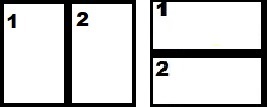
and now they become:
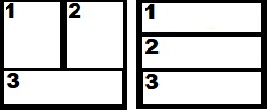
So now we can add three letters in the same space. That means that our letters become a bit smaller. And that is the very reason why I make you look at these boxes. There will be boxes with 4 letters later and actually even with 5 (it depends on how one counts) and still they need to neatly look the same size as those two letter blocks. I would recommend you to try to write words by hand and practice spacing.
Do you remember our rules for the spots 1 and 2 ? They are still valid. Let me refresh your memory.
- No.1 is always a consonant.
- No.2 is always a vowel. ( and this vowel decides the shape of our box, even of the three letter box)
- All spaces have to be filled in.
- No. 3 is always underneath and is always a consonant. (except for blocks with double vowels, but in that case the entire blocks looks different.)
Let's go !
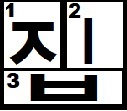
Like before we read the letters according to numbers: 1 = j, 2 = i, 3 = b (but here p because of being the last letter in a block) which reads altogether: jip = house / home
As we have seen in our last lesson, we need to add 에 / -e to the place if we want to go there.
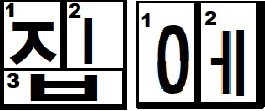
But look what happened now to our pronunciation. The letter ㅂ is no longer at the end of a word but right in the middle. So now it becomes a b
집에 = ji-be* = to the house / (to) home
* You might have noticed that I grouped the transcribed letters according to how we would pronounce them. The Korean blocks literally spell: jib-e
So let's go home, shall we ?
집에 가요. = Ji-be ka-yo. = I go home / you go home/ we go home/ Do we go home?/ Let's go home...Let's look a little at a consonant, we have learned already: ㅇ
We have seen it so far only as a silent place 1 filler. But it actually does have some sound to it. (not in place 1 though) It can however occur in place 3 and then sound like ng

Note that in real life slot 1 and 2 melt a bit together to help you gain some space: 공
Now let's read that: 공 = kong = ball
공을 kong-eul
Our ball has become an object (we added -eul to it - the object ending after a consonant)

공을 봐요. = kon-geul pwa-yo. = I see the ball.
Did you notice that there were two ㅇ in a row ? The first one was voiced since it came in end position of the syllable kong, the second was silent since it was the start of the syllable eul.
But right, I am getting carried away... we wanted a place, not a ball.
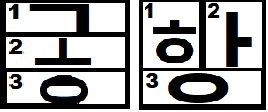
ㅎ = h
공항 = kong hang = the airport
- 어디에 가요 ? = eo-di-e ka-yo? = Where are you going?
- 공항에 가요. kong-hang-e ka-yo. I go to the airport.
At the risk of getting repetitive here, let me insist one more time on the fact that the vowel of slot 2 decides on the shape of our letter box.
With the vowels 아 이 어 에 애 we get:

with the vowels 오 우 으 we get:

Let's practice a bit more.
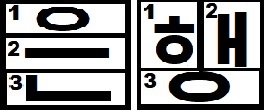
은행 = eun-haeng = the bank
- 은행에 가요? Eun-haeng-e ka-yo? Are you going to the bank?
- 네 은행에 가요 Ne, eun-haeng-e ka-yo. Yes, I go to the bank.
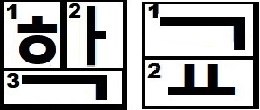
학교 = = hak-kyo = the school
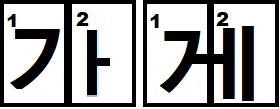
가게 ka-ge = the shop - (Here again we have ㄱ at word begin = k and in the middle of the word = g)
Do you still remember the new letter we learned ? ㅈ= j
With this letter we can write the word:

장 = jang = place
Let's have one more letter : ㅅ= s (one exception: before i = sh)
사 = sa, 서 = seo(saw), 소= so, 수= su, 세= se(say), 새= sae, but: 시= shi
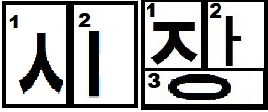
시장 = shi-jang = market
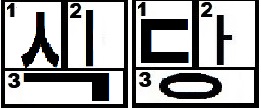
식당= shik-tang = restaurant
Remember, we can add a little line to our vowels in order to add a 'y' to them.
We have used 오 = o, 요 = yo
Btw. 우 = u (oo), 유= yu (yoo), 우유 = u-yu (oo-yoo) = milk
Well, now we need 어 = eo (aw) = yeo (yaw)

수영장= su-jeong-jang = swimming pool (the place where one does su-jeong = swimming)

역= yeok = (train) station
We can actually add the train in front of it. Train is an interesting word composed of two syllables:
기 = ki = spirit / energy and 차 = tsha = vehicle (also short word for car)
So let's add our kitsha to the station and we'll get:

Right there was a new letter : ㅊ= tsh; Look in the picture above.However it can also look slightly different:

ki-tsha-yeok = train station
Another interesting point is maybe to look at the different shapes the letter 'k' can take when fitting into our block. The first and the last letter of our word for train stain are the same letter: ㄱ
To end this lesson let's have a last look at all the vowels and consonants we have learned.
| Vowels | Consonants |
|---|---|
| 아 - a | ㅂ - b (beginning or end of a word: p) |
| 이 - i (ee as in see) | ㄷ - d (beginning or end of a word: t) |
| 어 - aw | ㅁ - m |
| 에 - ay (e as in pianoforte) | ㄴ - n |
| 애 - ae ( as 'ea' in yeah) | ㄹ - r (if last letter of a word: l) |
| 오 - o (as in tongue) | ㅎ - h |
| 우 - u (as 'oo' in school) | ㅈ -j (as in Jack) |
| ㄱ - k (beginning and end) - g (word middle) | |
| ㅅ - s (as in snob) | |
| ㅊ tch (as in match) |
